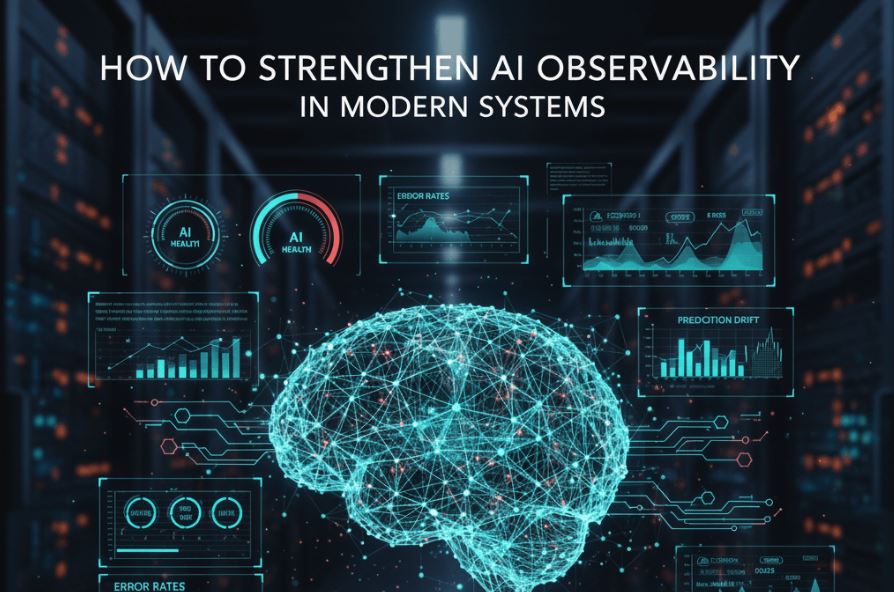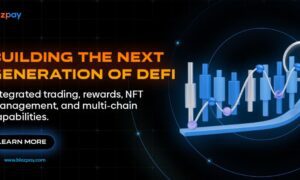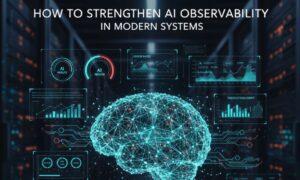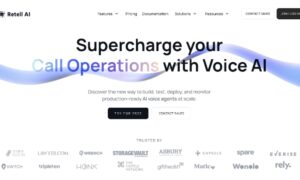Generative AI offers the financial sector unparalleled efficiency, but it also introduces unique governance challenges. This efficiency is made possible by robust AI infrastructure, which is essential for managing and monitoring the complex technical systems that support AI workloads. When AI models operate at scale, the risk of unpredictable, non-compliant outputs becomes a constant threat. To mitigate this, institutions must shift their quality assurance focus from static testing to continuous, deep observability of both ai workloads and the underlying systems. This approach not only helps monitor the complexity and scale of AI systems but also supports key application areas such as predictive analytics, ensuring operational efficiency and compliance.
AI observability is rapidly becoming a cornerstone of modern artificial intelligence (AI) systems, especially as organizations scale their use of advanced AI Systems across critical business functions. At its core, AI observability empowers teams to monitor, track, and deeply understand the real-time behavior of their AI models, ensuring that these systems operate as intended and deliver reliable outcomes. As AI systems grow in complexity and are entrusted with sensitive tasks, the stakes for operational efficiency and compliance rise dramatically.
Effective AI observability leverages a suite of observability tools and techniques to capture telemetry data, monitor key performance metrics, and quickly detect anomalies or deviations in AI workflows. This proactive approach not only helps organizations maintain stakeholder trust but also minimizes regulatory risks by providing transparency into how AI models make decisions. By embedding observability into the AI lifecycle, businesses can ensure their AI systems remain robust, compliant, and aligned with both internal policies and external regulations.
Why is AI Observability Critical for Financial Institutions Today?
The integration of Generative AI (GenAI) into core functions from customer service chatbots to compliance review systems is fundamentally reshaping the financial landscape. While the benefits are clear, offering productivity gains and enhanced customer experiences, the stakes for deployment are uniquely high for regulated financial institutions. Unlike a conventional software failure, a fault in a high-risk AI system can instantly translate into a regulatory breach, significant reputational damage, severe financial loss, or legal risks.
Observability in this context is no longer just about monitoring uptime; it is about establishing verifiable trust in the model’s behavior. Without robust AI observability, firms cannot guarantee that every automated interaction complies with internal policies and external regulations (such as GDPR or the upcoming EU AI Act), turning AI from an accelerator into an unacceptable risk factor.
According to Gartner, at least 30% of generative AI projects will be abandoned after the proof-of-concept phase by the end of 2025. This failure is frequently attributed to poor data quality, inadequate risk controls, and escalating costs, precisely the issues AI observability is designed to mitigate.
The focus has shifted from if AI will fail to when it fails, and the ability to prove compliance and trace the root cause instantly is the difference between a minor incident and a regulatory fine. Effective AI operations are essential for managing these risks, ensuring ongoing compliance, and maintaining reliable AI system performance.
AI in Financial Risk Management
AI is rapidly transforming financial risk management by enabling institutions to detect, predict, and mitigate potential threats with greater precision. Machine learning models can analyze vast amounts of transactional and market data to identify anomalies, assess creditworthiness, and forecast liquidity or operational risks in real time. When combined with strong observability frameworks, AI-driven risk systems help ensure that predictions and alerts remain transparent, compliant, and aligned with regulatory expectations. This fusion of AI and risk management not only enhances resilience but also builds trust in automated decision-making within financial ecosystems.
How Does AI Observability Differ from Traditional IT Monitoring?
Traditional IT monitoring using metrics like CPU utilization, server latency, and simple error rates is essential for infrastructure health, but provides zero insight into why a large language model (LLM) provided a non-compliant answer. Traditional solutions often require manual setup, making them labor-intensive and less adaptable to the dynamic needs of AI systems.
AI Observability is a specialized layer that monitors the AI system’s specific outputs and internal states. It addresses four critical areas that traditional tools cannot touch:
- Model Performance: Tracking output quality metrics (e.g., hallucination rate, toxicity, answer completeness).
- Compliance Adherence: Continuously evaluating responses against specific internal business rules or regulatory language.
- Configuration Integrity: Documenting and alerting on changes to model parameters (e.g., temperature, max tokens) that can silently shift behavior.
- Data and Prompt Drift: Identifying when live user inputs (prompts) or the underlying RAG data have changed in a way that causes the model to fail.
Research from McKinsey indicates that, despite high adoption interest, fewer than half of organizations deploying GenAI are actively mitigating the most commonly cited risk: inaccuracy (or hallucination). This gap underscores the urgent need for observability tools that track and validate the content output itself, not just the technical pipeline.
In this context, platforms like Avido are redefining how financial institutions approach AI quality and compliance. Avido provides purpose-built observability and assurance solutions designed to help organizations monitor AI behavior, validate model integrity, and ensure regulatory compliance throughout the AI lifecycle. By embedding such tools, financial firms can move from reactive monitoring to proactive governance.
Strengthening AI observability requires a dedicated platform that unifies collaboration, automated testing, and compliance-focused monitoring, the foundation for every successful AI deployment in a regulated environment. Unlike traditional approaches that rely on manual setup, modern observability platforms offer automated, plug-and-play solutions that reduce user intervention and accelerate deployment.
A key challenge in tracking AI performance, especially in the financial sector, is moving beyond basic technical metrics like uptime and linking AI performance directly to business value, risk mitigation, and regulatory compliance. Achieving this requires seamless integration of observability tools with existing systems to ensure unified monitoring and effective governance.
Key Principles of AI Development
Developing trustworthy and effective AI systems requires a strong foundation built on core principles such as transparency, explainability, fairness, and accountability. These principles are essential for fostering stakeholder trust and ensuring that AI models act in ways that are both reliable and aligned with societal values. The OECD AI principles serve as a global benchmark, advocating for AI systems that are transparent, explainable, and fair, while also emphasizing the importance of human oversight throughout the AI development process.
The EU AI Act further reinforces these ideals by establishing a comprehensive governance framework that mandates transparency, accountability, and responsible AI development. This governance framework requires organizations to document decision-making processes, provide clear explanations for AI-driven outcomes, and ensure that human oversight is integrated into high-risk AI applications. By adhering to these principles and frameworks, organizations can build AI systems that not only drive innovation but also uphold ethical standards and regulatory compliance, paving the way for trustworthy AI adoption.
Key Categories for AI Performance Metrics in Finance
Financial firms need to establish a comprehensive framework for Key Performance Indicators (KPIs) that align with their strategic goals, risk appetite, and regulatory obligations. The most effective metrics fall into four main categories: accuracy and precision, latency and throughput, explainability and transparency, and compliance and security. Additionally, token usage is becoming an important metric for tracking resource consumption and cost in generative AI models.
Expert Commentator– Domenico La Marca – Director Corporate Development at Mediobanca
Financial institutions should prioritize observability platforms that track key metrics, provide real-time alerts for unusual activity, and securely log system events. Effective observability clarifies model decision-making and helps meet regulatory transparency requirements. Robust tools allow clear tracing of unexpected model behavior, supporting prompt issue resolution and streamlined compliance reporting. This minimizes potential impacts on customers and regulators.
1. Business Impact and Efficiency
These metrics quantify the direct value the AI system delivers to the organization.
| Metric | Definition & Purpose | Examples in Finance |
| Return on Investment (ROI) | Overall financial gain vs. cost of AI implementation and maintenance. | Total cost savings from automated processes and revenue increase from new AI-driven products. |
| Operational Efficiency | Measures time or resource savings. | Reduction in manual review time for loans, cycle time for invoice processing, and hours saved in reporting. |
| Forecasting Accuracy | How closely AI predictions align with actual future outcomes. | Improvement in credit risk assessment accuracy, better cash flow projections. |
| Customer Experience | AI’s impact on client satisfaction and engagement. | Increase in Net Promoter Score (NPS), faster support resolution times from chatbots. |
- Model Effectiveness and Quality
These are the core technical metrics that ensure the model is functioning as intended, but contextualized for the business application.
| Metric | Definition & Purpose | Examples in Finance |
| Accuracy / Precision | How often the model is correct (for classification) or close (for prediction). | Fraud detection accuracy rate, false positive rate (e.g., flagging a legitimate transaction as fraudulent). |
| Model Drift | A decline in predictive accuracy over time as new, real-world data deviates from the training data. | Tracking the monthly degradation of a credit scoring model’s effectiveness. |
| Latency | The time it takes for the AI system to generate a decision or response. | Trading execution speed in high-frequency trading, and real-time response time for a virtual assistant. |
| Data Quality | The completeness, accuracy, and consistency of data used by the AI. | Percentage of required fields missing in input data, drift in key data distributions (e.g., changes in customer transaction patterns). |
3. Risk and Compliance (The “Beyond Uptime” Metrics)
In financial services, these are arguably the most critical metrics, ensuring the AI is responsible and governed. Some AI systems may be classified as ‘minimal risk’ under regulatory frameworks, meaning they are subject to fewer regulatory requirements compared to higher-risk systems.
| Metric | Definition & Purpose | Examples in Finance |
| Model Explainability | The degree to which a model’s decisions can be understood and justified. | Score on a standardized model transparency index, percentage of decisions with a clear, traceable audit trail. |
| Fairness / Bias | Metrics to detect discriminatory outcomes across different protected groups. | Disparity in loan approval rates or credit risk scores based on demographic data (e.g., race, gender) compared to the baseline. |
| Policy Adherence | Tracking whether AI recommendations align with internal and regulatory rules. | Exception handling rate (percentage of flagged anomalies), compliance flag rates (how often a decision triggers regulatory concern). |
| Security Incident Rate | Measures security failures tied to the AI system. | Number of malicious prompts (prompt injection) or unauthorized data disclosures over a period. |
How to Track AI Performance Effectively
Effective tracking requires a formal process and dedicated tools:
- Establish a Governance Framework: Define success metrics upfront and ensure they are aligned with strategic priorities such as efficiency, risk, and control.
- Real-Time Monitoring Dashboards: Use automated dashboards to provide instant visibility into live AI performance (e.g., accuracy, latency) and operational KPIs.
- Automated Alerts: Set up alerts for when key metrics (like fraud false positives or model bias metrics) exceed predefined risk thresholds.
- Continuous Audits and Feedback Loops: Conduct regular audits as part of ongoing risk management, and regularly review policies and monitoring practices to ensure ongoing effectiveness. Combine quantitative metrics with qualitative feedback from staff who use the AI (e.g., loan officers, fraud analysts) to capture both performance and usability.
- Traceability: Ensure every AI-driven action is logged and traceable for internal audits and regulatory reporting.
An AI Governance Framework in financial services is crucial for managing risks, ensuring regulatory compliance, and maintaining stakeholder trust. It extends beyond traditional Model Risk Management (MRM) to cover broader ethical, data, and security challenges associated with modern AI systems.
Core Components of an AI Governance Framework
A successful framework for banking and financial compliance generally includes these key components. Robust AI governance is essential to ensure compliance with regulations and maintain stakeholder trust.
- Ethical and Responsible AI Principles:
- Fairness and Bias Mitigation: Implementing strategies and tools to detect and mitigate bias in training data and model outcomes to prevent discrimination and ensure equitable results.
- Accountability: Establishing clear ownership and responsibility for AI system performance, outcomes, and failure. This defines who is accountable for an AI-driven decision.
- Human-Centricity/Oversight: Ensuring meaningful human-in-the-loop involvement, particularly for high-risk, critical decisions to prevent errors and ensure ethical alignment.
- Established AI ethics frameworks play a critical role in guiding responsible AI development and deployment, providing organizations with principles for fairness, transparency, and accountability. Ethical considerations are foundational to governance policies, ensuring that societal impacts, such as bias and human rights, are addressed from the outset.
- Governance Structure and Roles:
- Clear Structure: Defining a formal governance structure, often including an AI Governance Committee or Ethics Board with cross-functional representation (legal, compliance, risk, technology, business).
- Defined Roles & Responsibilities: Clearly assigning roles for overseeing the entire AI lifecycle (design, development, deployment, monitoring, and offboarding).
- AI governance practices, including industry standards and organizational procedures, help ensure responsible and ethical AI deployment across all stages.
- Comprehensive Data Governance and Quality:
- Data Integrity: Ensuring the quality, integrity, and representativeness of the data used to train and run AI models. AI models are only as good as the data they are trained on.
- Privacy and Security: Implementing robust measures like encryption, access controls, and anonymization to protect sensitive client data and comply with regulations like GDPR.
- Data Provenance: Tracking the origin, collection methods, and transformations of data used in AI systems.
- Regulatory and Compliance Alignment:
- Proactive Compliance: Aligning policies with evolving international and regional standards, such as the EU AI Act, NIST AI Risk Management Framework, and local financial regulations (e.g., those relating to consumer credit and fair lending). These frameworks are highly relevant for the private sector, providing guidance and requirements for organizations deploying AI technologies.
- Third-Party Risk Management (TPRM): Establishing a robust process for assessing and monitoring AI solutions acquired from third-party vendors, as this introduces “black box” and supply chain risks.
- Risk Management and Model Validation (MRM):
- Risk-Based Approach: Classifying AI systems by their level of risk (e.g., high, medium, low) to focus governance efforts and rigor on critical applications.
- Transparency and Explainability (XAI): Implementing processes and technologies to make AI decision-making understandable and auditable by stakeholders and regulators. This often requires comprehensive documentation of model logic and decision pathways.
- Continuous Monitoring and Auditing: Establishing mechanisms to continuously monitor model performance, detect data drift, model decay, bias, and anomalies in real time, with regular independent audits to verify compliance.
In summary, responsible AI governance is crucial for aligning AI initiatives with regulatory requirements and societal expectations, ensuring ethical, transparent, and trustworthy AI deployment.
Steps for Implementation
A practical approach to establishing the framework involves:
- Assessment and Planning: Evaluate existing AI use cases, conduct a gap analysis against regulatory requirements, and secure executive buy-in.
- Framework Design: Develop policies, principles, and a governance structure with clear escalation paths, including establishing transparent and compliant policies for model development.
- Implementation: Integrate governance requirements into the AI development lifecycle (AI/MLOps), invest in compliance-monitoring technology, and implement continuous training programs for all involved teams. Embed responsible ai practices such as secure environments, access controls, output validation, and audit logging to ensure accountability and traceability during deployment.
- Monitoring and Improvement: Establish automated auditing and reporting systems and a feedback loop to continuously review and adapt the framework as AI technology and regulations evolve. Involve non-technical stakeholders in training and feedback processes to promote transparency and accountability.
Key Challenges in AI Governance for Financial Services
While the implementation of an AI Governance Framework is necessary for responsible innovation, financial institutions face several complex challenges unique to their highly regulated environment. Strong governance frameworks are crucial to ensure responsible AI use across all levels where the organization operates, with leadership and oversight spanning every department. Overcoming these barriers is essential for successful, compliant, and scaled AI adoption.
| Challenge | Description | Mitigation Strategy |
| 1. Data Quality, Lineage, and Bias | AI models heavily rely on vast, high-quality data. Legacy systems, siloed data, and poor data quality lead to unreliable, non-compliant, and biased model outcomes. | Integrate Data Governance: Establish robust Data Lineage and Provenance tracking (tracking data from source to model output) to ensure full transparency. Implement automated Data Quality checks and Bias Auditing tools throughout the AI lifecycle. |
| 2. Regulatory Uncertainty and Compliance | The regulatory landscape is rapidly evolving (e.g., EU AI Act, sector-specific rules like fair lending/credit scoring). Interpreting and aligning AI systems with these unclear, shifting rules creates compliance risk. | Adopt a Risk-Based Approach: Classify AI models by risk level to prioritize governance efforts (e.g., focus rigor on high-risk credit or fraud models). Build Adaptive Frameworks that can quickly incorporate new regulatory requirements. |
| 3. Lack of AI and Risk Talent | A significant talent gap exists. Traditional compliance and risk teams often lack the technical expertise (data science, machine learning) to effectively validate and govern complex AI models, like Generative AI. | Invest in Upskilling and Collaboration: Implement continuous training programs to upskill existing compliance and risk professionals. Foster cross-functional teams where domain experts work directly with AI developers to build in controls from the start. |
| 4. Integration with Existing MRM and ERM | AI Governance must seamlessly integrate with existing Enterprise Risk Management (ERM) and Model Risk Management (MRM) frameworks, which were designed for less dynamic, traditional statistical models. | Modernize MRM Scope: Expand the scope of MRM to account for AI-specific risks (e.g., model drift, explainability) and components (e.g., third-party foundation models). Establish joint oversight processes across MRM, Compliance, Legal, and Tech teams. |
Key Challenges in AI Governance for Financial Services
While the implementation of an AI Governance Framework is necessary for responsible innovation, financial institutions face several complex challenges unique to their highly regulated environment. Overcoming these barriers is essential for successful, compliant, and scaled AI adoption.
Top 4 Challenges and Mitigation Strategies
| Challenge | Description | Mitigation Strategy |
| 1. Data Quality, Lineage, and Bias | AI models heavily rely on vast, high-quality data. Legacy systems, siloed data, and poor data quality lead to unreliable, non-compliant, and biased model outcomes. | Integrate Data Governance: Establish robust Data Lineage and Provenance tracking (tracking data from source to model output) to ensure full transparency. Implement automated Data Quality checks and Bias Auditing tools throughout the AI lifecycle. |
| 2. Regulatory Uncertainty and Compliance | The regulatory landscape is rapidly evolving (e.g., EU AI Act, sector-specific rules like fair lending/credit scoring). Interpreting and aligning AI systems with these unclear, shifting rules creates compliance risk. | Adopt a Risk-Based Approach: Classify AI models by risk level to prioritize governance efforts (e.g., focus rigor on high-risk credit or fraud models). Build Adaptive Frameworks that can quickly incorporate new regulatory requirements. |
| 3. Lack of AI and Risk Talent | A significant talent gap exists. Traditional compliance and risk teams often lack the technical expertise (data science, machine learning) to effectively validate and govern complex AI models, like Generative AI. | Invest in Upskilling and Collaboration: Implement continuous training programs to upskill existing compliance and risk professionals. Foster cross-functional teams where domain experts work directly with AI developers to build in controls from the start. |
| 4. Integration with Existing MRM and ERM | AI Governance must seamlessly integrate with existing Enterprise Risk Management (ERM) and Model Risk Management (MRM) frameworks, which were designed for less dynamic, traditional statistical models. | Modernize MRM Scope: Expand the scope of MRM to account for AI-specific risks (e.g., model drift, explainability) and components (e.g., third-party foundation models). Establish joint oversight processes across MRM, Compliance, Legal, and Tech teams. |
Focus on Explainability: Given the “black-box” nature of many modern AI models, Explainable AI (XAI) techniques are critical for regulators and stakeholders to understand how a decision was made. Lack of explainability directly impacts the ability to audit for fairness and compliance.
To effectively address the challenges of compliance and unexpected AI behavior, a robust governance framework must be backed by specialized technology and tooling. This section details the critical need for continuous monitoring and the specific tools that bring AI governance to life in a financial institution.
A. Addressing Unexpected AI Behavior: Drift
AI governance is fundamentally different from traditional IT governance because AI models are not static; they learn and degrade. The primary cause of unexpected, non-compliant, or faulty AI behavior in production is Drift.
1. What is Model Drift, and How Does it Manifest?
Model Drift refers to the degradation in a model’s predictive performance over time. A model that was 95% accurate during training may fall to 80% accuracy in production because the real-world environment has changed.
Drift manifests in three primary ways that directly impact financial compliance and risk:
| Type of Drift | Definition | Example in Finance | Impact on Governance |
| Data Drift (or Covariate Shift) | The statistical properties of the input data change over time. | A credit risk model was trained before the pandemic. Post-pandemic, unemployment rates and consumer debt distributions are entirely different. | The model is making decisions based on outdated assumptions, potentially leading to unfair or inaccurate lending decisions. |
| Concept Drift | The relationship between the input data and the target variable (what you are predicting) changes. | A fraud detection model accurately identified patterns in 2024. New fraud schemes emerge in 2025 that the old patterns cannot recognize. | The model silently fails to detect new risks, exposing the bank to financial losses and regulatory fines. |
| Configuration Drift | Changes are made to the model’s surrounding environment (e.g., data pipelines, API versions, software dependencies) that are not tracked or tested, leading to unexpected operational failure. | An engineer updates a data cleansing script upstream, inadvertently changing the currency format (USD to EUR) that the credit score model expects as input. | The operational integrity is broken. While the model itself is fine, its input is garbage, leading to system-wide prediction errors. |
2. Preventing Unexpected Behavior (The Solution)
The core solution to managing all forms of drift is Machine Learning Operations (MLOps), specifically, Continuous Monitoring and Observability.
- Continuous Monitoring: Tools are deployed to track the model’s performance and its operating environment in real-time, comparing production metrics against a defined baseline (the model’s performance during training/validation).
- Automated Alerts: When a metric (e.g., accuracy, fairness score, or data distribution) crosses a predefined tolerance threshold, an alert is triggered for the risk and validation teams to investigate and initiate a remediation (retraining or decommissioning the model).
B. Key Tooling for Operationalizing AI Governance
Effective AI Governance requires a dedicated suite of tools often referred to as an AI Governance Platform to automate oversight and create an auditable record across the AI lifecycle.
| Tooling Category | Purpose | Governance Function | Example Tools/Concepts |
| 1. Model Inventory & Risk Assessment | Centralized repository for all AI assets (models, datasets, owners). | Tracks the Accountability and Traceability of every model; enables risk-based prioritization. | AI Governance Platforms (e.g., OneTrust, BigID), Enterprise GRC Systems. |
| 2. Continuous Monitoring (MLOps) | Tracks model performance, data quality, and drift in real-time post-deployment. | Detects drift and performance degradation immediately, fulfilling the need for Ongoing Model Validation. | Specialized AI/ML Observability Platforms (e.g., Arize AI, Fiddler AI, WhyLabs), Azure ML Model Monitor. |
| 3. Explainable AI (XAI) | Generates human-understandable explanations for complex “black-box” model decisions. | Ensures Transparency and Explainability for compliance (e.g., justifying a loan denial to a customer or a regulator). | SHAP, LIME, Integrated XAI Features in MLOps Tools. |
| 4. Policy-as-Code & Enforcement | Translates regulatory and ethical policies into executable code and guardrails. | Enforces Ethical Guardrails and Regulatory Compliance directly within the development and deployment pipelines. | Open Policy Agent (OPA), Automated CI/CD Pipelines. |
The move from manual, periodic validation to Automated, Continuous Governance is the defining characteristic of a mature AI governance program in financial services.
AI Agents and Observability
AI agents, including chatbots and virtual assistants, are transforming industries such as financial services and customer support by automating tasks and enhancing user experiences. However, to ensure these AI agents operate reliably and ethically, organizations must implement robust observability tools and practices. Monitoring agent performance through telemetry data and custom metrics allows teams to proactively detect potential risks, performance issues, or compliance gaps.
Automated tools can streamline the process of identifying anomalies and maintaining high standards of data privacy and ethical conduct. Human oversight remains crucial, providing an additional layer of accountability and ensuring that AI agents align with organizational values and regulatory requirements. By continuously monitoring and optimizing AI agents, organizations can maintain stakeholder trust, deliver superior customer experiences, and uphold ethical standards in every interaction.
Integrating AI Governance with Enterprise Risk Management and Assurance
The final, and arguably most critical, pillar of the AI Governance Framework is ensuring it does not operate in a vacuum. AI risk must be absorbed into the firm’s existing Enterprise Risk Management (ERM) structure to be effectively managed and audited.
A. Aligning AI Risk with Enterprise Risk Management (ERM)
AI risk is not a new, isolated category of risk; it amplifies and manifests across existing risk pillars within a financial institution.
1. Mapping AI Risks to Traditional Risk Categories
Effective governance requires translating technical AI failures (like Model Drift) into language that is relevant to the Board and Risk Committee (e.g., Operational Risk, Reputational Risk).
| AI Risk Type | Traditional ERM Category | Financial Sector Consequence |
| Bias/Fairness Failure | Compliance / Regulatory Risk | Fines from regulators (e.g., in Fair Lending laws), lawsuits, and mandatory remediation. |
| Model/Data Drift | Operational Risk | Inaccurate predictions (e.g., failed fraud detection, incorrect loan pricing) lead to financial losses. |
| Lack of Explainability | Reputational Risk | Inability to justify a decision to a customer, eroding public trust, and leading to media scrutiny. |
| Configuration Drift | Technology / Cyber Risk | System failure, service outage, or data leakage due to undocumented pipeline changes. |
2. Establishing the “Three Lines of Defense” for AI
The classical financial services risk structure must be adapted for AI:
- 1st Line (Model Owners/Developers): Responsible for designing and running the model responsibly, including implementing MLOps tools for continuous monitoring.
- 2nd Line (Risk Management/Compliance): Defines the risk appetite, sets drift and fairness thresholds, conducts model validation, and ensures compliance with internal policy and external regulation.
- 3rd Line (Internal Audit): Provides independent assurance that the 1st and 2nd lines are operating effectively, verifying that the AI governance framework is followed and that audit trails are complete.
B. Assurance and Auditability Mechanisms
For AI to be auditable, its entire lifecycle must be transparent and its decisions traceable. This requires a shift from static audit snapshots to continuous assurance.
1. The Importance of End-to-End Traceability (Audit Logs)
Auditability hinges on being able to answer the fundamental question for any AI-driven decision: “Who did what, when, where, and why?”.
- Data Provenance: Tracing the data used for training and inference back to its original source.
- Model Lineage: Documenting every version, parameter change, and retraining event of the model.
- Decision Attribution: For every output, logging which specific feature inputs and model versions were used to generate the result.
2. The Role of the Internal Auditor
Internal Audit plays a key role in AI governance by:
- Reviewing Controls: Assessing the controls over AI-generated outputs, reviewing data classification, and evaluating data sovereignty compliance programs.
- Assessing Monitoring: Ensuring that the 2nd line of defense has set appropriate monitoring thresholds (e.g., for drift) and that the alerting system is functional and timely.
Conclusion
A successful AI Governance Framework for financial services is one that moves beyond simple compliance to achieve Trustworthy AI. This is accomplished by embedding three core capabilities into the firm’s operations:
- Transparency and Explainability (XAI): Ensuring that model decisions are understandable to stakeholders (customers, developers, regulators).
- Continuous Robustness: Using MLOps tools to manage drift and ensure the model consistently performs as intended.
- Accountability: Establishing clear roles (Chief AI Officer, Model Owners) and processes that map to the ERM framework.
The AI Governance Framework for Financial Services rests on four pillars. First, it requires a Foundational Structure establishing clear accountability via a tiered model risk and assigned ownership. Second, it mandates Ethical Design and Compliance by integrating regulatory rules, proactively mitigating bias, and using Explainable AI (XAI) to ensure transparency. Third, it is operationalized through Technology (MLOps), which provides continuous monitoring to detect and manage detrimental Model Drift in real time. Finally, the framework ensures full Integration with ERM and Assurance, mapping AI risks to traditional categories and enforcing end-to-end traceability for independent auditability and regulatory trust.
The broad adoption of international AI governance principles, such as the OECD AI principles, by governments and organizations worldwide further underscores the importance of implementing robust frameworks that align with global standards.
Frequently Asked Questions (FAQs)
1. What is the biggest difference between AI Governance and traditional IT/Model Governance?
The biggest difference is that AI systems are dynamic, not static. Traditional governance deals with fixed code and documented processes. AI Governance must manage Model Drift, the continuous, silent degradation of a model’s performance in production due to changes in real-world data or concept relationships. This necessitates a shift from periodic, manual audits to Continuous Monitoring and MLOps tooling to ensure ongoing compliance and accuracy.
2. Which regulatory area is most frequently impacted by AI bias in banking?
The most frequently impacted regulatory area is Fair Lending and consumer protection laws (like the Equal Credit Opportunity Act – ECOA in the US). If an AI model used for credit scoring or loan approval exhibits bias against a protected class (e.g., race, gender), the financial institution can face significant fines, lawsuits, and mandated remediation from regulators like the Federal Reserve, the OCC, or the CFPB.
3. How does the “Three Lines of Defense” principle apply specifically to AI?
- 1st Line: Model Owners and Developers; They are responsible for building, monitoring, and operating the model and implementing the controls.
- 2nd Line: Risk Management and Compliance; They are responsible for defining the risk appetite, setting the monitoring thresholds (e.g., for drift and fairness), and performing independent model validation.
- 3rd Line: Internal Audit; They provide independent assurance by verifying that the 1st and 2nd lines are functioning correctly, the controls are adequate, and the complete audit trail (data provenance and model lineage) exists.
4. What is the practical purpose of Explainable AI (XAI) in a bank?
The practical purpose of XAI is to ensure transparency and traceability for high-stakes decisions. XAI tools like SHAP and LIME allow a bank to generate a clear, human-understandable reason for why a specific customer decision was made (e.g., “Your loan was denied because your debt-to-income ratio exceeded 40%”). This is essential for:
- Regulatory Compliance: Fulfilling the “right to explanation” for denied applications.
- Model Debugging: Helping developers understand why a model is misbehaving or exhibiting bias.
5. What specific documentation is most critical for proving AI governance to a regulator?
The most critical documentation is the Model Risk Management (MRM) File and the Automated Audit Logs. Specifically, a regulator will want to see evidence of:
- Risk Tiering: How the model was classified (High, Medium, Low).
- Fairness Testing Results: Data showing the model was tested for bias, and the results met policy thresholds.
- Continuous Monitoring Records: Real-time metrics proving that the model’s performance and data quality did not drift outside of accepted tolerance limits while in production.
About Expert
Domenico La Marca, Director of Corporate Development at Mediobanca, is a seasoned professional with strong expertise in M&A, financial planning, and strategic growth. With years of experience across leading financial institutions in Europe, he specializes in evaluating investment opportunities, managing due diligence, and supporting long-term corporate strategy.



































